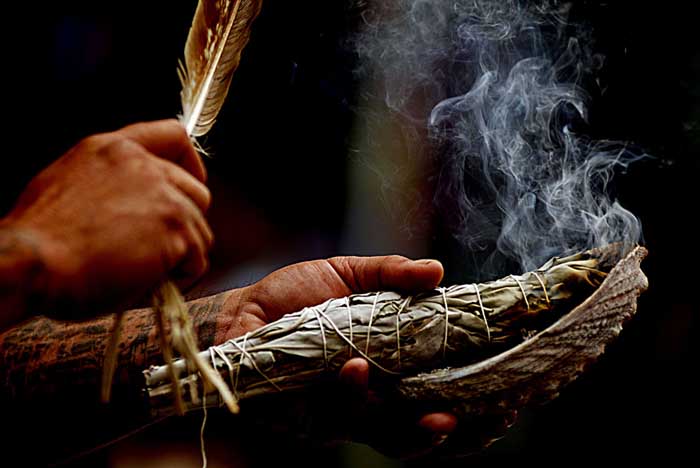 Submitted by Claire de Lune on
Submitted by Claire de Lune on

By Stephanie Yeh
Shamanic smudging—or just smudging—is an age-old tribal tradition which has been used for centuries to create harmony and peace. There are many different shamanic smudging ceremonies, and different tribes use a variety of herbs for smudging.
To define it more clearly, shamanic smudging is the burning of herbs or incense for cleansing, purification, protection of physical and spiritual bodies, banishment of negative energies and creation of sacred space. You can use smudge sticks (herbs that are tied into a bundle for easier handling), braided herbs and botanicals (like sweetgrass) or loose herbs (burned on charcoal or mugwort, or in a firepit). Shamanic smudging releases the energy and fragrance of the herbs and botanicals so they can heal, cleanse and purify.
In many traditions, shamanic smudging involves a four directions ceremony or prayer, which sends specific kinds of smoke or prayers into the four directions. Different tribes have different smudging prayers that “program” the smoke to do a specific action, such as cleansing or aiding in divination.
In general, shamanic smudging can be used in daily life for practical purposes—to restore physical, mental and emotional balance; to shield against negative energies; to cleanse yourself, your magickal tools and your space; and to restore you sacred space.
<><><> COMMON HERBS USED IN SMUDGING <><><>
Although different tribes and traditions use different herbs for shamanic smudging, some of the most popular herbs include desert sage, white broadleaf sage, juniper, pinon (sometimes in resin form), sweetgrass, copal (in resin form), mugwort, lavender and sacred tobacco. Here are some general uses for the different herbs often used for smudging:
- PINON RESIN
Primarily fire element though can also be used as for four-element general purposes. Has a pleasant and meditative fragrance. Is cleansing, strengthening, warming, and used by Native American cultures for its spiritual and healing properties. Produces a thick stream of smoke, and is excellent for refreshing the senses and reviving a tired soul.
- COPAL GOLD RESIN
Primarily fire and water elements though can also be used as for four-element general purposes. When burned, the scent is sweet, resinous, slightly woody, mildly earthy and spicy. Was a holy incense used by the peoples of Mesoamerica. Traditionally used as incense in divinatory and cleansing ceremonies. The resin contains aromatic chemicals called terpenes, which make it volatile and flammable. Used by Mayan shamans prior to ingesting mushrooms.
- MYRRH RESIN
Primarily earth element though can also be used as for four-element general purposes. Produces a lot of smoke when burned, very earthy, piney scent. Gathered from an almost leafless Middle Eastern shrub called the Commiphora Molmol. It was used by the ancient Egyptians in rituals of Healing and Passing. It is one of the ingredients used by the Egyptians to embalm bodies. Useful for spirituality, meditation, happiness, release, transformation, strength, confidence and stability.
- FRANKINCENSE RESIN
Primarily fire element though can also be used as for four-element general purposes. Is the resin of an African tree and produces a rich, dense smoke when burned. Used extensively in meditation and healing. In numerous religious traditions, frankincense's spiritual scent was believed to confer divine blessing. Pliny the Elder mentioned it as an antidote to hemlock poisoning.
- DESERT SAGE
Primarily air element though can also be used as for four-element general purposes. Has a somewhat sharp, light and refreshing scent. One of the most sacred herbs among Native Americans. Used to purify the mind, body and spirit before prayer, meditation, ritual or ceremony. Also used to purify sacred items such as pipes, magical tools, tarot decks and eagle feathers. Can be used for area, house and personal cleansings. Some people carry a small amount of Sage in a pocket or medicine pouch to insure personal and spiritual safety.
- JUNIPER
Primarily fire element though can also be used as for four-element general purposes. Has a sharp, piney scent. Excellent to stimulate and revive when tired in body, mind or Spirit. Used in ancient times for ritual purification of temples. Smoke believed to aid clairvoyance. Also useful for purification and to stimulate contact with other worlds. Burned during the Plague to resist disease
- LAVENDER
Primarily air element. Has a light, aromatic and refreshing scent. Useful for attracting peace, happiness and restful sleep. Also reduces depression, grief and sorrow. Aids in meditation and divination, and often said to aid in manifestation. Known as Elf Leaf, Nard, Nardus, Spike and Lavandar. Traditionally associated with fairies and elves
- WHITE BROADLEAF SAGE
Primarily air element though can also be used as for four-element general purposes. This is a broad leaf sage is highly prized for its strong aromatic properties (strongest of the different types of sage). Considered the king if all sages. Excellent for meditation, divination, smudging, cleansing and purification.
- YERBA SANTA LEAVES
Traditionally used for enhancing psychic abilities, magical protection, healing and spiritual strength. Excellent for meditation and divination. Said to be ruled by the moon. One Native American tribe rolled the leaves into balls, dried it in the sun and chewed it for a natural mouthwash.
- HIBISCUS FLOWERS
Primarily fire and water elements. Produces a sharp, invigorating scent that lasts for a long time after burning. Often used in divination and psychic communication. Excellent for rejuvenating the senses and restoring life force.
- ROSE FLOWERS AND PETALS
Primarily water element. Produces a heavy, warm, aromatic scent with just a hint of sharpness – scent lasts a long time after burning. Excellent for meditation, divination, increasing psychic abilities, contacting powers and beings in other dimensions and psychic communication. Also traditionally associated with attracting love, conferring peace, stimulating sexual appetites and enhancing beauty.
- SWEETGRASS
Primarily air element. As its name suggests, sweetgrass produces a sweet and light fragrance that does not last for long. Excellent for cleansing sacred space. Sweetgrass is a rare grass which is found growing wild in very few places. Traditionally, sweetgrass is believed to invite the good spirits.
You can burn these herbs singly or in combination with each other. One good combination that covers all four magical elements of air, fire, water and earth is pine resin and sage (either desert sage or white broadleaf sage). This combination is appropriate for general use, cleansing, ceremony and ritual.
To order smudging supplies, visit the Esoteric School Store at http://www.shamanschool.com/magicsupplies.html.
<><><> WHEN TO SMUDGE YOURSELF <><><>
Smudging yourself on a daily basis can be very helpful in keeping yourself balanced and maintaining a peaceful state of being. However, you should definitely use shamanic smudging techniques when you’ve been around people who are ill, depressed, fearful, angry or generally emotionally unbalanced; before meditating to create a calm state of being; when you’re feeling blue or depressed; or when you’ve been under a lot of stress.
Smudging yourself is easy. If you’re using a smudge stick, light the smudge stick on a candle flame. Hold the stick in the flame until there is a lot of smoke and the stick is burning well (that’s why a candle is better than a match—it can take a while to get the stick really smoking). Using a feather (or feather fan) or your hand, gently fan the smoke onto your body, starting at the top of the body and moving downward. Get the back of your body as best you can (it’s often easier to use a smudge pot and loose herbs for this). When you’re done, inhale a little of the smoke (just a little!) to purify your insides.
If you’re using a smudge pot or Firebowl and loose herbs, light the herbs (using self-lighting charcoal—not the barbeque kind!) until it is smoking well. Then, put the Firebowl on the ground and stand over it with your legs spread and feet on either side. Weave back and forth in the smoke until you have been thoroughly cleansed. Clothing is optional for this approach, and smudging in the nude is recommended for a more thorough cleansing. Again, when you’re done, inhale a little of the smoke to purify your insides. People often feel more relaxed, lighter and brighter after smudging.
If you’re going to use the smudge smoke during meditation, use a charcoal burner or Firebowl, light the herbs and enjoy the scent and smoke as you meditate. Meditating with these herbs often produces a deeper and longer-lasting state of relaxation and contemplation.
http://www.articlesfactory.com/articles/metaphysical/what-is-shamanic-smudging.html